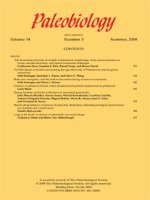Although there is extraordinary interest in the quantitative measurement of species diversity, published statements on the behavior of the components of species diversity are contradictory and lead to opposite conclusions. In this paper, we demonstrate that the confusion is due to two key oversights: (1) whether or not biological sampling is carried out within or between communities; and (2) determination of the statistical distribution underlying a biological community, which is crucial for the evaluation of all of the components of diversity measurement.
The problem of sampling “within” a population or community is basically distinct from the equivalent integration of structure and diversity measurement “between” differing multispecies populations. “Within-community sampling” is defined as a set of biological samples from a statistical population that has a particular statistical distribution or a constant value for the associated parameter(s). As the number of individuals increases along with the number of species, for a log series distribution, the diversity measures of Shannon's H, log series or Fisher's α, and Simpson's Index 1/λ remain constant while the evenness measures of Buzas-Gibson's E and Pielou's J decrease. For a log-normal distribution, J will remain constant while E decreases and α, 1/λ, and H increase. No single measure of evenness remains constant over all statistical distributions, so if constancy as a type of independence is required, the appropriate distribution must first be determined. Each species ensemble is mathematically fixed by the applicable statistical distribution.
In contrast, “between-community sampling” is defined as a set of biological samples from different statistical distributions and/or the same distribution with differing parametric values. If sampling is between communities and S increases while the number of individuals remains constant, then all the other measures considered here increase. The exception is the broken stick, for which E remains constant while H, J, α, and 1/λ increase.
Herein we propose and justify the use of the log-series distribution (with regression on the information decomposition equation) as a null model for determination of community structure and demonstrate that the community structure of a Miocene bed at Calvert Cliffs, Maryland, is a log series by use of this new unified methodology.





